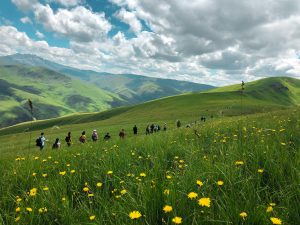Kosovo is a European country rich in history, known for its stunning natural landscapes and vibrant skylines. In this article, Greenor will provide you with essential information for your travels to Kosovo, including tips on safety, transportation, attractions, and culture. Whether you’re interested in exploring historic sites, enjoying outdoor adventures, or immersing yourself in local culture, Kosovo offers something for every traveler to discover and enjoy.
Public transport
Public transportation in Kosovo mainly consists of buses, minibusses (called “furgons”), and taxis. Buses run between major cities, while furgons are smaller and faster, but can be crowded. Taxis are convenient, especially at night, but fares should be negotiated. Trains are less common. Tickets can easily be bought through Gjirafa. In Pristina, the public transport system covers most of the tourist spots. For instance, with bus 7c, you can reach the Mother Teresa Boulevard, a prominent attraction. You can buy a ticket for a single ride or opt for a 24-hour pass. Since English isn’t widely spoken, it helps to have Google Translate downloaded on your phone as a backup. Cash is preferred for payments, and remember to keep your valuables secure. Overall, public transportation is safe, but staying vigilant is important, especially in crowded areas.
Good to know:
In Kosovo, you can take a taxi from the airport to Pristina for around 20 euros. Make sure to arrange the payment before getting in, and locals advise taking taxis with colors, as the white ones are more likely to scam.

Payment and currency
The official currency of Kosovo is the Euro, adopted unilaterally in 2002. This means that the Euro is widely accepted for transactions throughout the country.
Payments in Kosovo can be made using cash or card. Credit and debit cards are accepted in many establishments, particularly in larger cities like Pristina and Prizren, but it’s advisable to carry some cash for smaller purchases and in more rural areas where card acceptance may be limited. ATMs or MiniBanks are readily available in urban centers and tourist areas, allowing travelers to withdraw Euros using their international bank cards. However, it’s wise to inform your bank of your travel plans beforehand to avoid any issues with card usage abroad, such as potential security blocks.
Overall, accessing and using money in Kosovo is relatively straightforward for international travelers, with the Euro being the primary currency and ATMs widely available for cash withdrawals.
Language
In Kosovo, a self-proclaimed new country, the primary languages spoken are Albanian and Serbian, reflecting the recent historical context. However, due to Kosovo’s Western orientation and its young population, English is also widely spoken. International travelers will find that many locals are proficient in English and willing to assist. Nevertheless, having Google Translate as a backup tool is advisable for smoother communication, especially in more remote or less touristy areas.

Visa requirements for travel
For international travelers planning to visit Kosovo, it’s essential to understand the visa requirements. Citizens of many countries, including those from the European Union, the United States, Canada, Australia, and several others, can enter Kosovo visa-free for short stays ranging from 90 days to six months, depending on their nationality. However, it’s crucial to verify the specific visa regulations based on your country of citizenship before traveling. Travelers should ensure their passports are valid for at least six months beyond their intended stay in Kosovo. If you need a visa, it’s typically recommended to apply in advance through the nearest Kosovo embassy or consulate. Additionally, travelers should be prepared to provide proof of sufficient funds, a return ticket, and accommodation details upon entry. Always check the latest visa requirements and regulations before planning your trip to Kosovo.
Religion
The predominant religion in Kosovo is Islam, with the majority of the population being Muslim. However, there are also significant communities of Serbian Orthodox Christians and Roman Catholics. Allthough around 90% of the population is muslim, only around 15% considers themselves as actively practising the religion. Kosovo is very western orientated and compared to neighbouring Muslim countries.
In terms of safety, Kosovo has made significant progress since the conflict in the late 1990s, enhancing stability and security. Generally, the main tourist areas in Kosovo are considered safe for international travelers. All adventures with Greenor take place in areas deemed safe for international travel.
However, as is prudent anywhere in the world, it is advisable to exercise caution, especially in areas close to borders and regions where tensions might be higher.
Additionally, for international travelers interested in exploring Kosovo’s rich history and culture, visiting landmarks such as the historic monasteries, Ottoman old towns, and stunning natural landscapes can provide an enriching experience. Engaging with local customs and traditions can further enhance your journey in Kosovo.
Seasons
Determining the best time to visit Kosovo largely depends on your preferences for weather and activities. Spring (March to May) and autumn (September to November) are generally considered the best seasons, offering pleasant temperatures and fewer crowds. During spring, the landscape bursts into vibrant colors, making it ideal for outdoor activities like hiking and exploring cultural sites. Autumn showcases stunning views and is perfect for scenic drives and wine tasting in the vineyards. Summer (June to August) brings warm temperatures, making it suitable for outdoor adventures such as swimming in lakes and rivers or attending music festivals. However, summers can be hot, with temperatures averaging between 25°C to 30°C (77°F to 86°F). Winter (December to February) is cold, with temperatures often dropping below freezing, especially in the mountains, but it’s a great time for winter sports enthusiasts to enjoy skiing and snowboarding. Average temperatures during winter range from -5°C to 5°C (23°F to 41°F), depending on the region.
Tap water. Is it safe to drink?
In Kosovo, the tap water is generally safe to drink in urban areas, including major cities like Pristina and Prizren. The water quality meets European standards in many places, and residents often consume tap water without issue. However, in some rural or remote areas, the water infrastructure may be less developed, and the quality of tap water could be inconsistent. Therefore, it’s advisable for international travelers to exercise caution and consider alternative sources of drinking water, such as bottled water, especially when visiting more rural parts of the country or if they have sensitive stomachs. Bottled water is widely available for purchase at grocery stores, convenience stores, and hotels throughout Kosovo. Overall, while tap water in urban areas is generally safe, travelers should use their discretion and consider their individual circumstances and preferences.
History of Kosovo
Kosovo’s history is rich and complex, shaped by its strategic location at the crossroads of Europe and the Balkans. Throughout the centuries, Kosovo has been inhabited by various civilizations, including the Romans, Byzantines, Ottomans, and Serbs. In the late 20th century, Kosovo experienced significant turmoil, marked by ethnic tensions and conflict. The Kosovo War in the late 1990s led to the intervention of NATO forces and ultimately to Kosovo declaring independence from Serbia in 2008. This declaration, however, is not recognized by all countries. Today, Kosovo is a young and dynamic country striving for stability and economic development. Visitors to Kosovo can explore its tumultuous past and vibrant culture through its many museums and historical sites. In Pristina, the capital city, notable museums include the Kosovo Museum, which offers insights into the region’s history, and the Ethnological Museum, showcasing traditional Kosovar culture. The National Library of Kosovo, an architectural marvel, is also worth a visit. In Prizren, visitors can explore the Kalaja Fortress and the Sinan Pasha Mosque, as well as enjoy the numerous cafes and restaurants along the Bistrica River. Additionally, both cities offer bustling bazaars where visitors can immerse themselves in local life and find unique souvenirs. Many of these museums and cultural activities are free or have nominal entry fees, making them accessible to all.
